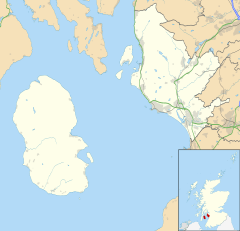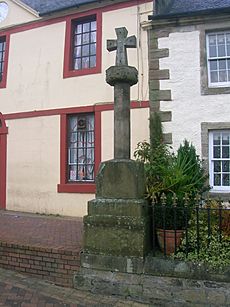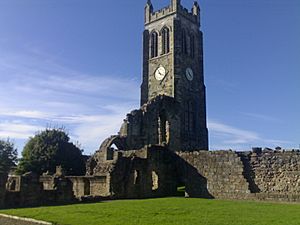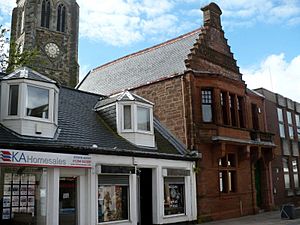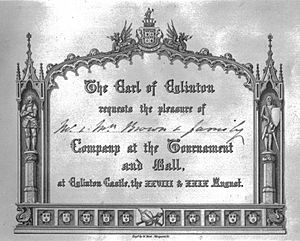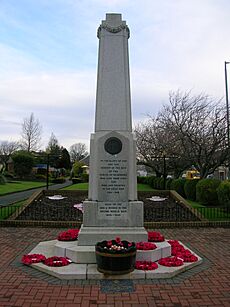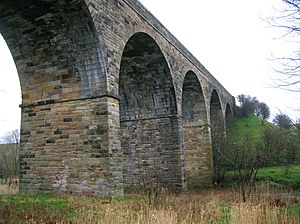Kilwinning facts for kids
Quick facts for kids Kilwinning
|
|
|---|---|
| Town and former civil parish | |
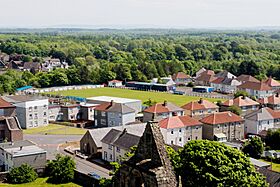 Aerial view over Kilwinning with Abbey Park (now abandoned) in the centre, 2018 |
|
| Population | 16,100 (2020) |
| OS grid reference | NS2943 |
| • Edinburgh | 65 miles (105 km) |
| • London | 379 miles (610 km) |
| Civil parish |
|
| Council area | |
| Lieutenancy area |
|
| Country | Scotland |
| Sovereign state | United Kingdom |
| Post town | KILWINNING |
| Postcode district | KA13 |
| Dialling code | 01294 |
| Police | Strathclyde |
| Fire | Strathclyde |
| Ambulance | Scottish |
| EU Parliament | Scotland |
| UK Parliament |
|
| Scottish Parliament |
|
Kilwinning is a town in North Ayrshire, Scotland. It is located on the River Garnock, just north of Irvine. It's about 21 miles (34 km) southwest of Glasgow. Kilwinning is often called "The Crossroads of Ayrshire" because of its location. In 2001, about 15,908 people lived there, and by 2016, the population had grown to an estimated 16,460.
Contents
History of Kilwinning
Kilwinning has a long history, especially when it comes to religion in Scotland. Early Christian missionaries, like the Celtic Christians or Culdees (who were like monks), found this area a good place to spread their faith. Towns like Kilmarnock, West Kilbride, Kilbirnie, and Kilwinning all have names that show they once had "Cillean," which were small churches or cells of the early Celtic Church.
Long ago, the town was known as Sagtoun, or Saint's Town. This name came from Saint Winning, who started a church here in the early 600s. We don't know for sure who Saint Winning was. Some people think he was an Irish saint named Finnian of Moville. Others believe he was a Welshman named Vynnyn. The Aberdeen Breviary, a book from 1507, says he was from Scotland.
In early medieval times, the word "Scots" or "Scotland" could also refer to Ireland. The Aberdeen Breviary says Saint Winning came from a "Scottish province" (meaning a region of Ireland at that time) and sailed to "Lesser Scotland" (which was the name for the country we now call Scotland). This means he might have been Irish.
The first part of the town was at Bridgend and Corsehill. The Kilwinning Abbey and its buildings, gardens, and dovecote (a building for doves) were on the other side of the river. In 2010, the Kilwinning Community Archaeology Project dug at Kilwinning Abbey. This helped people learn a lot about how people lived there in medieval times.
Old Buildings and Bridges=
Abbot Adam's Bridge was built a very long time ago, in the Middle Ages. Much of the original bridge is still standing today. It was made wider in 1859.
Where Kilwinning Is Located
Kilwinning is in Ayrshire, in west-central Scotland. It sits on the banks of the River Garnock. Nearby towns include Stevenston to the west (by the coast) and Irvine to the south. Inland, to the north, is Dalry.
Kilwinning and Freemasonry
Kilwinning is famous for being home to the very first Lodge of Freemasonry in Scotland. Freemasonry is a very old club or society with special traditions. When all the Lodges (local groups) were given numbers, Kilwinning was given the number '0'. This shows it is the "Mother Lodge of Scotland," meaning it's the original one.
No one is completely sure how the Lodge started. The first written proof is from 1598 and 1599. These old rules, called The Schaw Statutes, say Kilwinning is the "head and second lodge of Scotland."
The Lodge has its own story that it began when Kilwinning Abbey was being built in the 1100s. During that time, groups of skilled masons (stone builders) worked together. They were given special rights to build big religious buildings in the Gothic style. The story says that a group of these foreign masons came from Italy or Cologne to build Kilwinning Abbey. They then started the first official group of working masons in Scotland. It's thought that their meetings were held in the chapter house of the Abbey. If you look closely at the old walls of the Abbey, you can still see many different marks made by these masons.
Kilwinning Today
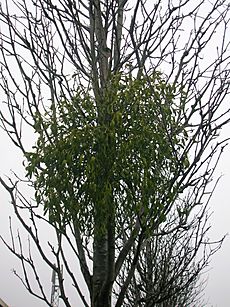
In 1966, Kilwinning became part of the Irvine New Town plan. This meant the town grew very quickly. New housing areas were built on farmland around the town to make space for more people.
Today, Kilwinning has a historic town centre where people can walk. Bridgend, which used to be a separate village, is now part of the town. Around these older areas are newer housing estates like Corsehill, Woodwynd, Blacklands, Pennyburn, Whitehirst Park, and Woodside. The last three were added when Kilwinning became part of Irvine New Town.
Kilwinning is a mix of different areas. Places like Whitehirst Park and Woodside have expensive houses and are considered wealthy. Parts of Woodwynd also have nice areas. Other parts of town, especially Blacklands, Pennyburn, and Corsehill, are more working-class areas.
Older residents sometimes call the Blacklands area the "Ironworks." This is because the Eglinton Iron Works used to be there. The only building left from that time is now the Nethermains Community Centre. For many years, a huge "slag hill" (a pile of waste from the ironworks) stood over the area. It was removed in 1979, and the stone was used to build a terminal at Hunterston. The area was then turned into Almswall Park.
The Main Street in Kilwinning has recently been updated. This was part of a project by the Irvine Bay Regeneration Company to improve the Irvine Bay area.
Eglinton Castle and Country Park
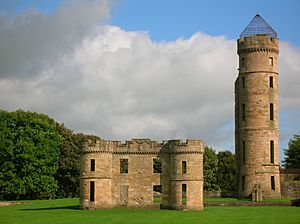
Eglinton Castle was the old home of the Earls of Eglinton. It's located just south of Kilwinning. The castle was built between 1797 and 1802. It was designed in a Gothic style, looking like an old castle with a large round tower in the middle (100 feet or 30 meters tall) and four smaller towers (70 feet or 21 meters tall). It was considered one of the most beautiful castles, second only to Culzean Castle. The first stone for the new Eglinton Castle was laid in 1797. The 12th Earl of Eglinton was proud that the ceremony was done by Alexander Hamilton of Grange, who was the grandfather of the famous American, Alexander Hamilton.
The castle is best known today for the Eglinton Tournament in 1839. This was a huge and amazing show! Archibald Montgomerie, the 13th Earl of Eglinton, paid for and organized this event. It was a medieval-style tournament that brought thousands of visitors. People came to watch knights fight and see ladies dressed in fancy clothes. One of the guests was Napoleon III, who later became the Emperor of France.
The tournament was a funny mix of old and new! Special trains, some of the very first ever, ran from Ayr to bring people to the event. This was even before the train line officially opened in 1840.
Today, the castle is a ruin. The Tournament might have been a turning point for the Eglinton family. It cost a lot of money, and this happened at the same time they were spending huge amounts on the Ardrossan harbour and the Glasgow, Paisley and Ardrossan Canal. The castle started to fall apart after its roof was removed in 1925. During World War II, it was even used by soldiers for demolition practice. The remaining parts were pulled down to their current level in 1973. Now, Eglinton Country Park is a popular place for visitors.
Jobs and Businesses
In medieval times, Kilwinning was known for archery. Later, the town was important for coal mining, quarrying (digging for stone), making iron, and producing textiles (cloth). These industries have mostly stopped now.
The Pringle knitwear company, famous for its sweaters, first made its products in Kilwinning. Another company, Wilson's Foods, had a factory on the Eglinton Estate, but it has also closed.
The old mill on the River Garnock was briefly owned by Blackwood Brothers of Kilmarnock before it closed completely. The area where the mill was hasn't changed much. Part of the old factory has been taken down, and the former mill shop is now used as offices and a showroom for a local car dealership.
The Nethermains Industrial Estate has many factories and workshops. These were built in the 1960s and 1970s for light industry. Fullarton Computer Industries is one of the big employers there. Today, Kilwinning's businesses include making plastics and electronics. Almost a quarter of the people who work in Kilwinning are in manufacturing jobs.
Getting Around Kilwinning
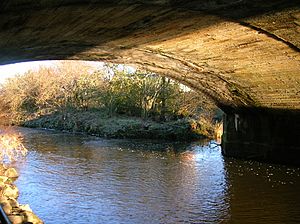
Trains
Trains stop at Kilwinning railway station and connect to:
- Glasgow Central – Largs + Ardrossan Harbour
- Glasgow Central – Ayr
Roads
Kilwinning is connected to the rest of Ayrshire by roads. The A78 dual carriageway goes around the town. This road connects to the A71 and A77 dual carriageways, and to the M77 motorway which goes to Glasgow.
Buses
Kilwinning has bus services run by Stagecoach West Scotland and Shuttle Buses. Some routes include:
- 11 Ardrossan – Kilmarnock
- 25 Montgomerie Park / Bourtreehill / Broomlands / Irvine Cross – Kilbirnie / Beith
- 27 Irvine – Whitehurst Park (Evenings Mon – Sat)
- 29 Irvine / i3 Industrial Area – Whitehurst Park (Mon – Sat)
- 38 Riverway Retail Park – David Gage St (Mon – Sat)
- X34 Glasgow – Irvine Cross / Irvine railway station / Bourtreehill
- X36 Glasgow – Ardrossan
Air Travel
Glasgow Prestwick Airport is easy to reach from Kilwinning. It's only 12.9 miles (21 km) south on the A78 dual carriageway, which takes about 21 minutes by car. Or, you can take the train for about 14 minutes (three stops). From Prestwick Airport, you can fly to many places in the UK, Europe, and North America.
Schools and Learning
Kilwinning has one secondary school, Kilwinning Academy. Until recently, St Michael's Academy also served the town.
The primary schools in Kilwinning are: Corsehill Primary School, Abbey Primary School, Blacklands Primary School, St Winning's Primary School, Pennyburn Primary School, Whitehirst Park Primary School, and St Luke's Primary School. St Michael's Academy joined with St Andrew's Academy of Saltcoats. Both old Catholic secondary schools have been taken down. A new building, now called St Matthews Academy, stands nearby and teaches students from towns around Saltcoats.
A large campus of Ayrshire College was built in Kilwinning in 1998 and opened in August 2000. This college has brought good things to the town, as students spend money at local businesses. Since 2013, this campus has been part of Ayrshire College, which also includes the Largs campus, Kilmarnock College, and Ayr College.
It's worth noting that 37% of Kilwinning residents aged 16–74 do not have formal qualifications, which is slightly higher than the national average of 33%.
Kilwinning also has several Community Halls, including Nethermains Community Centre, Cranberry Moss Community Centre, Whitehurst Community Centre, Pryde, The Woodwynd Hall, and the Love Memorial Hall. These are places where people can meet and hold events.
Sports in Kilwinning
Archery
The Ancient Society of Kilwinning Archers is a very old group, thought to have started in 1483. While official records only go back to 1688, older notes seem to confirm this early start.
Archery is still a popular sport in Kilwinning today. Every year, on the first Saturday in June, they hold the "papingo shoot." A wooden bird is placed on a pole and hung from the clock tower of the old Abbey. Archers then try to shoot off its wings, and then the bird itself. In 2014, Michael Portillo visited the Ancient Society of Kilwinning Archers for his TV show, Great British Railway Journeys, which was shown on the BBC.
Football
Kilwinning Rangers F.C., also known as The Buffs, play their home games at Buffs Park. They play in the second level of the West of Scotland Football League (WoSFL) and wear blue and white striped jerseys.
The team started in 1899 as a youth football club. They first played at Blacklands Park, sharing it with another team called Eglinton Seniors. On July 26, 1902, they officially became a Junior football club.
The name "Buffs" was first used on September 21, 1900. The local newspaper, the Irvine Herald, reported that the "so-called Buffs" had a big win over Kilmarnock Belgrove. Kilwinning Rangers have had many successful times. They are proud to say they were the first and last Ayrshire Club to win the Scottish Junior Cup in the 1900s!
Dirrans Athletic AFC was formed in 1946. They currently play in the Ayrshire Amateur Football League Premier Division.
Kilwinning Sports Club, or KSC, opened in July 2002 in the Pennyburn area of Kilwinning.
In 2022, Kilwinning Rangers Amateurs changed their name to Eglinton F.C. and joined the fifth level of the WoSFL.
Famous People from Kilwinning
- Robert Baillie (1602–1662), a religious leader and professor.
- Helen Muir Bearpark (1942-1996), a leading researcher on sleep in Australia.
- Bernard, an important church leader (Abbot and Bishop).
- Crawford Boyd, a footballer.
- Des Browne, a politician.
- Quintin Craufurd, an author.
- Joe Donnachie, a footballer.
- Hal Duncan, a writer.
- Henry Eckford, a shipbuilder.
- Julie Fleeting, a footballer.
- Colin Friels, an actor.
- Colin Hay, a musician and lead singer of the band Men at Work.
- Joseph Kain, an American businessman and politician.
- James MacMillan, a composer.
- Dougie McCracken, a footballer.
- Gerry McGowan, a footballer.
- Lewis Morrison, a footballer.
- Andrew O'Hagan, an author and novelist.
- James Service, an Australian politician who was Premier of Victoria, born in Kilwinning in 1827.
- Robert William Service, a poet and writer who spent part of his childhood in Kilwinning.
- Gordon Smith, a footballer.
- Penny Tranter, a weather forecaster.
- John White, a Church of Scotland minister who was Moderator twice.
- Lorna J Waite, an academic, community activist, and poet who wrote in Scots and English.
Images for kids
See also
 In Spanish: Kilwinning para niños
In Spanish: Kilwinning para niños


